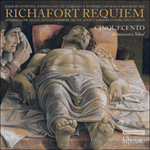Nicolas Gombert sets
Musae Jovis in the Phrygian mode. Gombert was perhaps ten years younger than Appenzeller, being born in the early to mid-1490s, and his six-voice lament seems to be in the style of the 1530s, when most of his works appeared, rather than of Josquin’s year of death, 1521. Like Appenzeller he includes archaic elements, and in particular one that refers unmistakably to Josquin: the ‘Circumdederunt me’ tenor appears, in the long notes of an old-style cantus firmus, but here it is transposed down one note, beginning on E instead of F, and thus conforming to the Phrygian tonality of the piece. Since Josquin’s
Nymphes des bois, itself a lament for an older composer, employed exactly this procedure with the ‘Requiem aeternam’ chant, the intention is clear. The comparative rarity with which Gombert employed cantus firmus technique underlines the significance of the gesture in this case. The style of the motet is a constant ebb and flow of counterpoint, with much less overt formal punctuation than Josquin’s music; unity is achieved by limiting the melodic material used, giving an introspective tone to the setting. The final statement of Josquin’s elevation to the heavens is marked with a turn to triple time.
from notes by Stephen Rice © 2012
Nicolas Gombert choisit de mettre en musique le poème
Musae Jovis dans le mode phrygien. Gombert, qui avait peut-être dix ans de moins qu’Appenzeller, naquit entre le début et le milieu des années 1490, et sa déploration à six voix semble opter davantage pour le style des années 1530 (quand parurent la plupart de ses œuvres) que pour celui de 1521, année de la mort de Josquin. Comme Appenzeller, il inclut des éléments archaïques dont un, en particulier, renvoie immanquablement à Josquin: le tenor «Circumdederunt me», qui apparaît dans les longues d’un cantus firmus à l’ancienne, mais transposé une note plus bas, en démarrant sur mi au lieu de fa, pour se conformer à la tonalité phrygienne de la pièce. Comme Josquin procède exactement de même avec le plain-chant «Requiem aeternam», dans
Nymphes des bois—une déploration écrite pour un compositeur plus ancien—, l’intention est claire. Et on mesure d’autant mieux la portée de ce geste que Gombert recourt relativement peu à la technique du cantus firmus. Le style du motet est un constant flux et reflux de contrepoint, avec une ponctuation formelle bien moins flagrante que chez Josquin; l’unité est obtenue par une restriction du matériau mélodique employé, d’où le ton introspectif de l’œuvre. L’énonciation finale de la montée aux cieux de Josquin est marquée par un passage à la mesure ternaire.
extrait des notes rédigées par Stephen Rice © 2012
Français: Hypérion
Nicolas Gombert vertonte das Gedicht
Musae Jovis im phrygischen Modus. Gombert war vielleicht zehn Jahre jünger als Appenzeller (er war zu Beginn oder in der Mitte der 1490er Jahre geboren worden) und sein sechsstimmiges Lamento scheint im Stil der 1530er Jahre komponiert zu sein, als der Großteil seiner Werke erschien, und nicht im Jahr von Josquins Tod, 1521. Ebenso wie Appenzeller bindet auch er altmodische Elemente mit ein, von denen sich insbesondere eins unweigerlich auf Josquin bezieht: der „Circumdederunt me“-Tenor erklingt in den langen Noten eines alten Cantus firmus, jedoch hier um einen Ton nach unten transponiert, so dass er auf E und nicht F beginnt und dadurch mit der phrygischen Kirchentonart, in der das Stück gehalten ist, übereinstimmt. Da Josquin in seinem Werk
Nymphes des bois, das seinerseits ein Klagestück für einen älteren Komponisten ist, bei dem Cantus planus „Requiem aeternam“ in genau derselben Weise verfährt, ist die Absicht deutlich. Die relativ ungewöhnliche Technik, mit der Gombert den Cantus firmus behandelt, unterstreicht in diesem Falle die Bedeutung dieser Geste. Der Stil der Motette ist ein konstantes An- und Abschwellen des Kontrapunkts, wobei die Musik deutlich fließender ist als bei Josquin; Einheitlichkeit wird durch Begrenzung des melodischen Materials erreicht, was der Vertonung einen introspektiven Ton verleiht. Wenn Josquins Erhebung in den Himmel zum letzten Mal besungen wird, wechselt die Musik in einen Dreierrhythmus.
aus dem Begleittext von Stephen Rice © 2012
Deutsch: Viola Scheffel



 Richafort: Requiem & other sacred music
Richafort: Requiem & other sacred music
